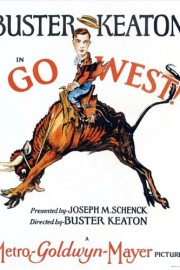Go West
The more one dives into Buster Keaton’s films, the more one sees how imperfect he was when it came to making “great” comedies. Of course, comedy and greatness are both inherently subjective, so what qualifies as both is in the eye of the beholder. But I wouldn’t put a “Go West” or “College” on the same level of “The General” or “Our Hospitality” or “Sherlock Jr.,” but rather a tier or two below those films. It’s nonetheless difficult to hold “Go West” to that same standard I would those films, though, because it’s a matter of Keaton finding a way to make his type of comedy in a different setting, and seeing what lands comedically. Is it a classic like those films? No, but there’s at least one great sequence in it that is worthy of consideration with the best of Buster’s work, which honestly, is more than I can say of the last film of his I reviewed, “Spite Marriage.”
“Go West” is Keaton making a western. Once again, he stars as basically himself (the credits only list his character’s name as, “Friendless”), and he is in dire straights financially. He takes his possessions down to the local pawn shop, and gets nickles for them. He asks for work, if the shop owner has any. He doesn’t, so he needs to take some possessions with him to leave town. That’s less money he gets. He needs food, so once again, that’s less money for him. He has to travel in a freight car to the city, but it’s too frantic for him, so he heads out west. He finds work as a ranch hand, but he also finds the love of his life in a neglected cow he calls Brown Eyes. This is the first live thing that has shown him kindness in his travels, and he takes it upon himself to care for her. Unfortunately, like the rest of the cattle on the ranch, Brown Eyes is slated for the slaughterhouse. For Keaton, that will not do, and he makes it his mission to save her from that fate, but not without some mischief first.
The great sequence in “Go West” basically makes up the last 15 minutes of the movie, as Keaton’s character makes his way on to the train holding the cattle, and tries to break out Brown Eyes. When they pull in to the train station in California where the cattle are headed, he gets off with Brown Eyes, and in the process, releases the rest of the heard, as well. The image of hundreds of cattle roaming the streets of California is an impossible image to forget, and the individual scenes Keaton pulls off with cattle in awkward places are some of the funniest sight gags he put on film. Even better is when he figures out a way to lead them to the slaughterhouse, making sure his boss and family are not left in financial ruin. It’s one of his finest sustained sequences, leading to a payoff that makes us happy for his character, but also just happy, in general, as he has given us one of the most entertaining conclusions to his movies in his career. As a whole, “Go West” leaves much to be desired, but Keaton knows the secret to a memorable movie in the ending, and he gave us a doozy with this one.










